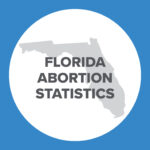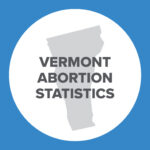Abortion Reporting: Oklahoma (2019)
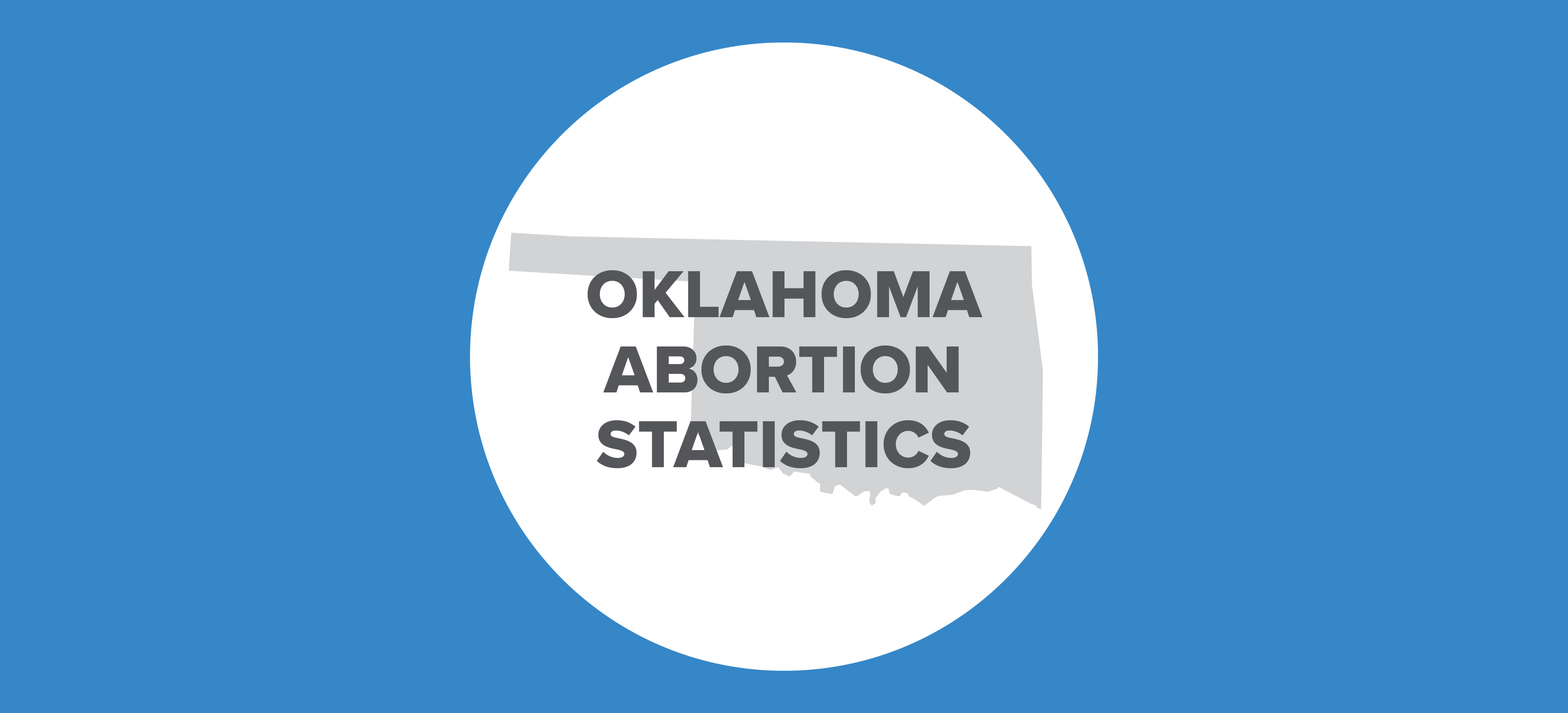
Oklahoma’s 2019 abortion report was released in June 2020 by the Oklahoma State Department of Health. Oklahoma abortions declined slightly after increasing for two years.
Changes in Oklahoma Abortions, 2018-2019

Information on Planned Parenthood’s Oklahoma abortion market share is not included in the abortion report.
Abortion Totals and Trends
In 2019, there were 4,995 abortions reported in Oklahoma, less than half a percent fewer than the previous year (Fig. 1). Chemical abortions declined by five percent, composing 50 percent of total Oklahoma abortions in 2019. The abortion rate, or the number of abortions per 1,000 women of childbearing age, also fell by less than half a percent between 2018 and 2019 (Fig. 2). Most of the information in Oklahoma’s annual report is for all abortions occurring in the state, including those performed on nonresidents. Oklahoma suppresses numbers smaller than five to maintain confidentiality.
State Report Summary
Demographic Information
A majority of the abortions reported in Oklahoma (89 percent) were on Oklahoma residents. Eight percent of the abortions were performed on women from other states, most of whom traveled from states bordering Oklahoma: three percent of Oklahoma abortions were performed on Arkansas residents, two percent each on women from Missouri and Texas, and one percent on women from Kansas. An additional three percent were performed on women whose residency was not reported.
Ten percent of Oklahoma abortions were performed on girls under the age of 20. Fifty-eight percent of the abortions were on women in their twenties, with 30 percent on women ages 20 to 24 and 28 percent on women ages 25 to 29. Eighteen percent were performed on women in their early thirties (ages 30 to 34), and 13 percent were on women age 35 or older. Eighty-one percent of the abortions were performed on unmarried women, compared to 19 percent on married women. Among states that report the marital status of women who get abortions, Oklahoma reports a relatively high percentage of abortions on women who are married.
Just over half of the abortions reported in Oklahoma were performed on white women (53 percent). Twenty-one percent were performed on black women. Five percent of Oklahoma abortions were on American Indian or Alaska Native women, and three percent were on Asian or Pacific Islander women. Eighteen percent of the abortions were on women of other races. CLI estimates that the black abortion rate was 14.0 abortions per 1,000 women of childbearing age, three times the white rate of 4.6. More than half of Oklahoma abortions were on women who had a high school education or less: 40 percent had a high school diploma or its equivalent, and 12 percent had not finished high school. Thirty-seven percent of the women had attended some college, and 10 percent had a bachelor’s degree or more.
Most of the women undergoing abortions in Oklahoma had previously experienced pregnancy. Just 29 percent had no prior pregnancies, while a fifth had one previous pregnancy and over half (51 percent) had two or more. Many of these previous pregnancies ended in live births. Twenty-four percent had one previous live birth, and 38 percent had more than one. In comparison, the majority of the women who obtained abortions in Oklahoma (71 percent) reported no previous abortions. Twenty percent reported one prior abortion, and just nine percent reported two or more previous abortions. Eighteen percent of the women had previously suffered a miscarriage.
Oklahoma’s abortion reporting form provides women with the option to share their reasons for seeking abortion; women may select more than one reason. In 2018, the majority of the reasons reported were socioeconomic or familial concerns. The number of abortions due to medical emergencies, risk to the mother’s life, rape, and incest were suppressed.
Medical Information
Almost three-quarters of the abortions occurring in Oklahoma (73 percent) were performed at eight weeks of gestation or earlier. Twelve percent were performed between nine and 10 weeks, and eight percent were performed between 11 and 12 weeks. Four percent occurred from 13 to 15 weeks, dropping to three percent between 16 and 20 weeks. There were 16 abortions, 0.3 percent, performed at 21 weeks of gestation. Oklahoma limits abortion at 20 weeks post-fertilization, approximately 22 weeks of gestation, and no abortions were reported this late in pregnancy. In 2019, probable post-fertilization age was ascertained in advance of 98 percent of the abortions.
Fifty percent of Oklahoma abortions were chemical abortions. Thirty-five percent were performed using suction curettage, and 10 percent were dilation and evacuation procedures. Two percent were performed using dilation and curettage, and another two percent were performed via other or unknown methods. For 85 percent of the chemical abortions, the physician was in the room when the woman took the first pill.
Forty-seven percent of the women undergoing abortions received anesthesia. In addition, 34 unborn babies were reported to have been given anesthesia before they were aborted. Seventy-three percent of the abortions reported in Oklahoma were performed by doctors who specialized in obstetrics and gynecology, and 27 percent were performed by general practitioners.
Ultrasounds were performed in advance of 99 percent of the abortions, of which 72 percent were vaginal and 28 percent were abdominal ultrasounds. Fifty-eight percent of the pre-abortion ultrasounds were conducted by the doctor performing the abortion, two percent by a different doctor, and 40 percent by another individual. Additionally, ultrasounds were used during six percent and after 11 percent of the abortions. According to Oklahoma’s informed consent law, women with pregnancies of at least eight weeks post-fertilization must be offered the opportunity to listen to their baby’s heartbeat. Ninety-eight percent of the women were asked if they would like to hear the baby’s heartbeat, and 83 percent had the heartbeat made audible for them to hear.
After 26 percent of the abortions, the remains of the unborn baby were examined to make sure that no pieces were left in the mother’s body. The number of cases in which the baby’s sex was determined, as well as the number of male and female babies, were suppressed. Twenty-seven percent of the unborn babies were discarded as medical waste. Twenty-one percent were incinerated, and 20 percent were discarded at home, while nearly a third did not have the manner of disposal reported. It is likely that the unborn babies who were discarded at home, as well as many of the babies whose manner of disposal was unknown, were aborted through chemical abortions.
The precise number of abortions resulting in complications was suppressed,1 but there were eight known instances of failed abortion in which the pregnancy was ongoing. There were no reported instances of maternal mortality from abortion in 2019, and no babies were reported to have been born alive during abortions.
Legal and Financial Information
Oklahoma maintains an informed consent process to ensure that women are given all the facts and offered options, with an exception for abortions performed in cases of medical emergency. In 2019, 99 percent of the women undergoing abortions received the required medical information, and 99 percent were notified of the resources available to them. There were twenty medical emergencies, but the report does not indicate what sort of emergencies these were. Oklahoma does not allow the use of public facilities or the participation of public employees in abortion except for cases of risk to the mother’s life, rape, or incest against a minor; the number of these cases was suppressed in 2019.
Before a minor may obtain an abortion in Oklahoma, her parents must be notified and give consent. In 2019, 124 minors obtained abortions after their parents were notified; notice was provided in person for 81 abortions and via mail for 43 abortions. Exceptions to the parental notification and consent requirement are allowed when the minor girl is emancipated or is experiencing a medical emergency; the number of instances in which a minor obtained an abortion without parental notification in 2019 was suppressed. Girls may also petition a judge to waive the parental notification requirement, but no judicial waivers were reported in 2019.
The vast majority of the abortions occurring in Oklahoma in 2019 were covered by private funds (99 percent). Twenty-eight abortions were funded by Medicaid, and just five were covered by private insurance. Thirteen abortions were funded using some other means. Oklahoma does not allow private insurance to pay for abortion unless the woman’s life is in danger, although women may purchase optional insurance riders for abortion coverage, while state Medicaid covers abortion only in cases of rape, incest, or life endangerment. A majority of Oklahoma abortions (65 percent) cost between $601 and $700, while 28 percent cost between $501 to $600. Just six abortions cost less than $500. Three percent cost between $701 to $800, and five percent cost more than $800.
On average, 416 abortions occurred in Oklahoma each month. The month of March had the most (582), and December had the fewest (220).
Abortion Centers in Oklahoma
Oklahoma has four abortion centers, the majority of which are located in the Oklahoma City area. Two centers are in Oklahoma City proper, while the third is in a nearby suburb and the fourth is located in Tulsa. All four centers advertise both surgical and chemical abortions. One center is operated by Planned Parenthood, while the other three are independent abortion centers.
Oklahoma limits abortion at 20 weeks post-fertilization, or approximately 22 weeks of gestation. Of Oklahoma’s four abortion centers, Abortion Surgery Center advertises abortion up to 12 weeks of gestation, Planned Parenthood of Central Oklahoma City up to 13 weeks and 6 days, Tulsa Women’s Clinic up to 18 weeks, and Trust Women Oklahoma City up to 21 weeks and 6 days – just below the legal limit.
State Ranking
In 2016, CLI’s survey of abortion reporting in the 50 states, New York City, and the District of Columbia ranked Oklahoma’s reports at first place as the most detailed, comprehensive, and timely. To make the wealth of information in its annual report even more useful to Oklahoma policy makers, citizens and researchers, Oklahoma could cross-tabulate some of its data, for instance by reporting the gestational ages at which various abortion methods are used. Additionally, because so many reasons for abortion are provided and multiple reasons may be selected, Oklahoma could consider grouping similar reasons under one heading, such as “relationship concerns.”
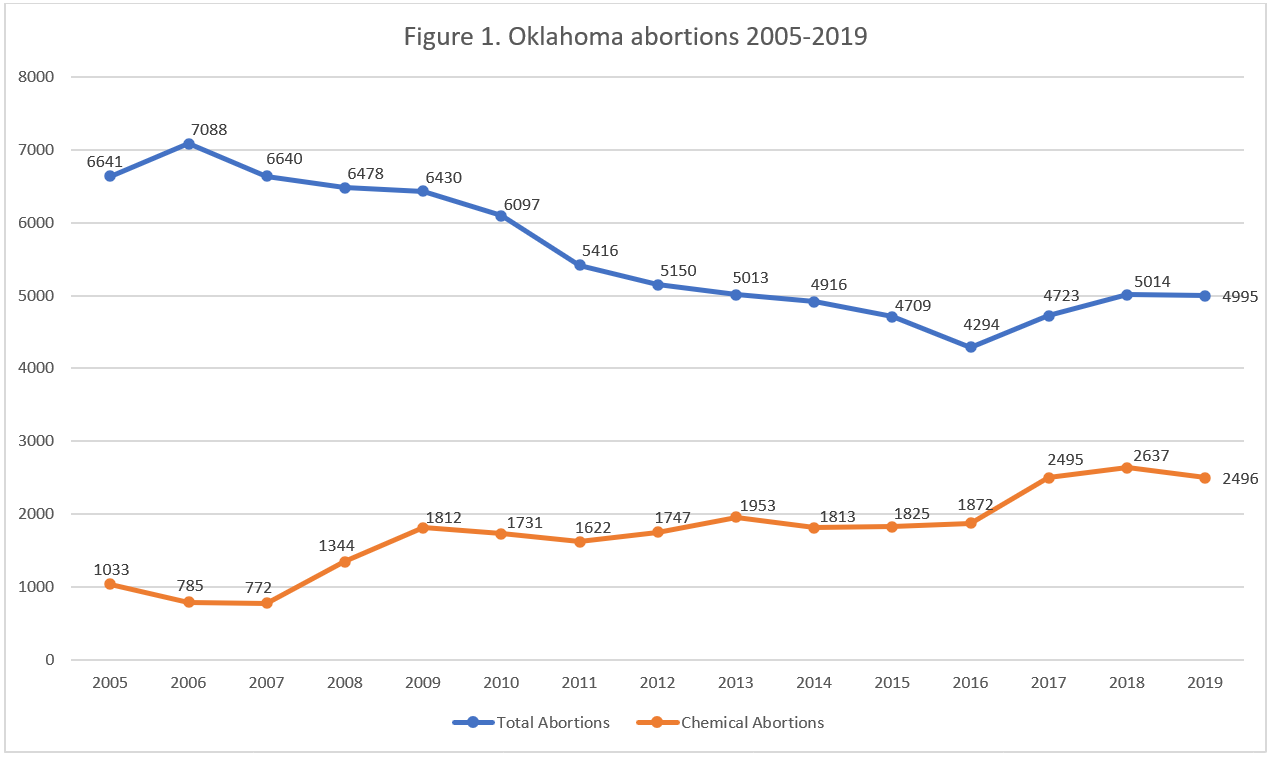
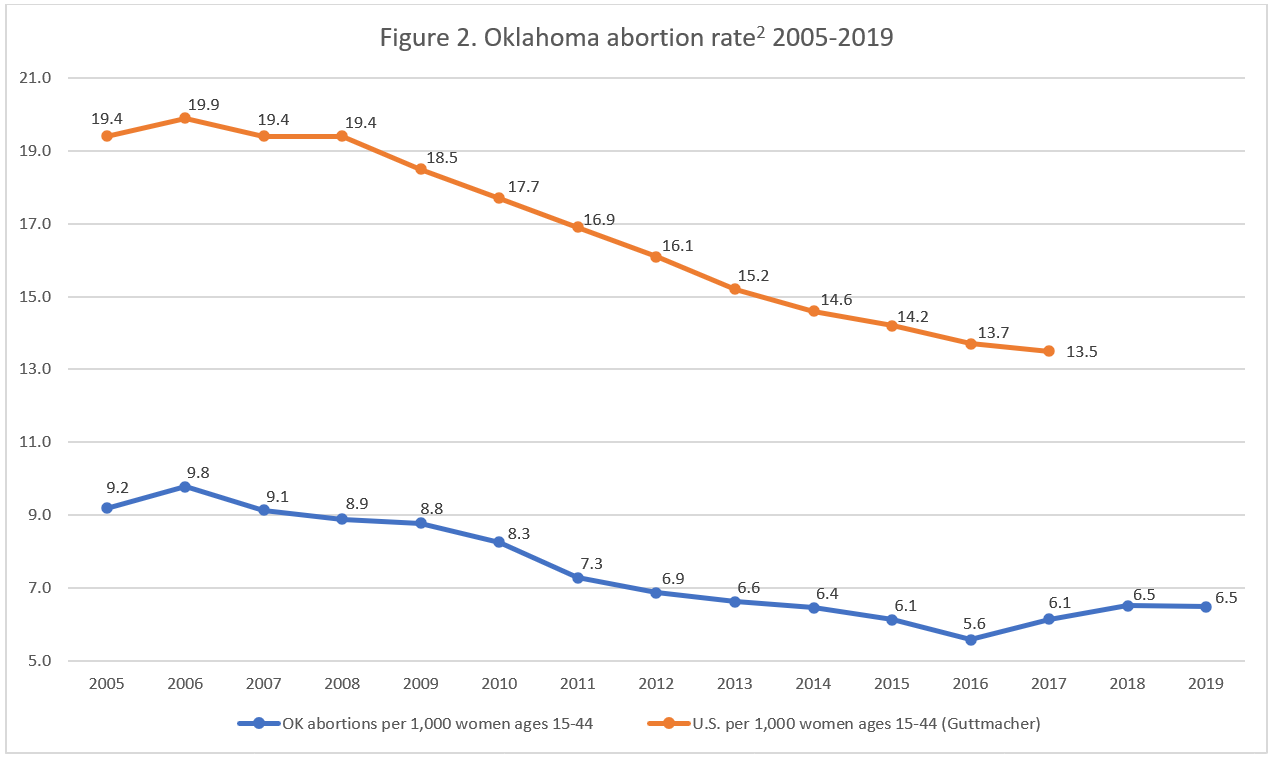
- Statistics on abortion complications reported here represent a minimal number of deaths and complications, as this data is collected in a non-systematic and non-verifiable way. As such, this data cannot be used to calculate either an accurate abortion mortality rate or an accurate abortion complication rate for the state.
- Rates were calculated by CLI using population estimates from the United States Census Bureau. The rates were calculated using the following formula: (total number of abortions performed in Oklahoma ÷ number of resident women ages 15-44) x 1,000. Rates may differ slightly from previous CLI articles due to revised population estimates.























